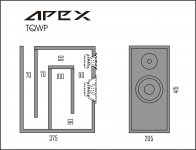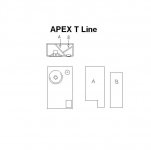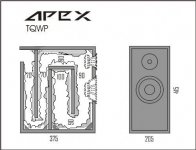A nice looking box, but which 6in driver in particular? Since like any other vented alignment the box tuning & volume of a QW pipe need to be appropriate for / designed for the intended drive unit's requirements, it would be useful to know which you had in mind.
A nice looking box, but which 6in driver in particular? Since like any other vented alignment the box tuning & volume of a QW pipe need to be appropriate for / designed for the intended drive unit's requirements, it would be useful to know which you had in mind.
Many 6in or 5in drivers can be used and tuning response with damping material.
This box is idea for test TQWT and I will share project with crossover.
Regards
Very possibly, but in what general region of Q and Vas for the alignment you anticipate / intend?
Indeed! A TQWP as shown would want a fairly low Q driver. A high Q driver would need an entirely different folding to place the driver nearer to the closed end. Finally, the overall volume of the pipe would depend on the Vas of the driver, which is all over the place in available 5-6" drivers.
Bob
Bob
Very possibly, but in what general region of Q and Vas for the alignment you anticipate / intend?
I intended to use VISATON AL130
http://www.visaton.com/pdfexport/de/servicestr.form?pid=/pdfexport/pdf/al130_8.html
but look at this box like TQWT idea.
Regards
AH! OK.
My first impression looking at the T/S parameters is that a Qts of 0.38 may be a little high for a TQWP, but probably doable. The Vas of 13l, though is going to produce quite a challenge making the passages small enough.
Good luck!
Bob
My first impression looking at the T/S parameters is that a Qts of 0.38 may be a little high for a TQWP, but probably doable. The Vas of 13l, though is going to produce quite a challenge making the passages small enough.
Good luck!
Bob
AH! OK.
My first impression looking at the T/S parameters is that a Qts of 0.38 may be a little high for a TQWP, but probably doable. The Vas of 13l, though is going to produce quite a challenge making the passages small enough.
Good luck!
Bob
Thanks, AL130 is from old T line box and I like this box size for small room.
Regards
Same question as before: what 8in driver, or range of parameters? They cover a rather broad range, and I don't believe that you'd suggest that it would produce identical results, irrespective of the driver.
Same question as before: what 8in driver, or range of parameters? They cover a rather broad range, and I don't believe that you'd suggest that it would produce identical results, irrespective of the driver.
This is design for diy and you can tweak box for your drivers if you want to build it.
Regards
Hi Apex, nice DIY ideas, as usual, thanks.
What about to try such design with an Aura NS6 ?That drive had in the recent past many DIY uses.
Or with that unnamed Celestion 5" Neo (http://www.diyaudio.com/forums/full-range/224047-celestion-5-sale-pe.html) that is on sale at Parts Express? They are both (expecially the Celestion) quite full-ranges, low Xmax.
What about to try such design with an Aura NS6 ?That drive had in the recent past many DIY uses.
Or with that unnamed Celestion 5" Neo (http://www.diyaudio.com/forums/full-range/224047-celestion-5-sale-pe.html) that is on sale at Parts Express? They are both (expecially the Celestion) quite full-ranges, low Xmax.
Last edited:
Hi Apex, nice DIY ideas, as usual, thanks.
What about to try such design with an Aura NS6 ?That drive had in the recent past many DIY uses.
Or with that unnamed Celestion 5" Neo (http://www.diyaudio.com/forums/full-range/224047-celestion-5-sale-pe.html) that is on sale at Parts Express? They are both (expecially the Celestion) quite full-ranges, low Xmax.
Try with KEF B110
B110 Type SP1003 Index hifiloudspeakers.info
Regards
what is the board thickness? I cannot calculate it from this diameter chain...
seems to be 10 mm but (375-90-100-70-70)/5 gives 9mm
something is wrong on the picture, mr Apex.
seems to be 10 mm but (375-90-100-70-70)/5 gives 9mm
something is wrong on the picture, mr Apex.
Last edited:
TQWT few question
Hi Mile, I ve started to look around this type of cabinet. If I understand right TQWT should be tappered in opposite direction to this shown on your drawing. I'd like to mount 6,5 " driver in similar construction, but lenght of TL should be for about 36HZ(FS) what gives more than 2m and more width and height on front panel.. As we can see on your drawing, you tuned this cabinet for about 70 Hz ( nearly 1,7 meter), but you didn't mentioned that it shouldn't be damped with wool because wool slows down air in this line, what virtually enlarges it. Can you comment this if i'm right?
Hi Mile, I ve started to look around this type of cabinet. If I understand right TQWT should be tappered in opposite direction to this shown on your drawing. I'd like to mount 6,5 " driver in similar construction, but lenght of TL should be for about 36HZ(FS) what gives more than 2m and more width and height on front panel.. As we can see on your drawing, you tuned this cabinet for about 70 Hz ( nearly 1,7 meter), but you didn't mentioned that it shouldn't be damped with wool because wool slows down air in this line, what virtually enlarges it. Can you comment this if i'm right?
Wrong on basically all points unfortunately. 😉
TQWT is currently [mis]used to describe conical horns that are compromised in cross section, i.e. a pipe that expands toward the terminus. Traditionally, it was used to describe the opposite, i.e. a pipe that narrows toward the terminus, although very few people use the term in that way these days (GM, myself & presumably the OP here also, but that seems to be about it).
The acoustic length of a pipe is a function of both physical length and its taper: a pipe narrowing toward the terminus is inherently mass-loaded, and has a lower fundamental resonance frequency to an untapered pipe of the same physical length. Conversely, a pipe that expands toward the terminus is a horn, and has a higher resonant frequency than a straight pipe of the same physical length: Resonances of open air columns
Wool stuffing does not significantly slow the speed of sound in a pipe:
http://www.quarter-wave.com/TLs/Test_Line_Results.pdf
http://www.quarter-wave.com/TLs/Damping_Coefficient.pdf
There is a little attenuation, but not to the extent often cited. Tapering the pipe will typically have a much more significant impact on the fundamental resonant frequency.
TLs of any kind are like any other vented box: they require the box tuning frequency and volume to be optimised for the requirements of the driver and the desired alignment.
TQWT is currently [mis]used to describe conical horns that are compromised in cross section, i.e. a pipe that expands toward the terminus. Traditionally, it was used to describe the opposite, i.e. a pipe that narrows toward the terminus, although very few people use the term in that way these days (GM, myself & presumably the OP here also, but that seems to be about it).
The acoustic length of a pipe is a function of both physical length and its taper: a pipe narrowing toward the terminus is inherently mass-loaded, and has a lower fundamental resonance frequency to an untapered pipe of the same physical length. Conversely, a pipe that expands toward the terminus is a horn, and has a higher resonant frequency than a straight pipe of the same physical length: Resonances of open air columns
Wool stuffing does not significantly slow the speed of sound in a pipe:
http://www.quarter-wave.com/TLs/Test_Line_Results.pdf
http://www.quarter-wave.com/TLs/Damping_Coefficient.pdf
There is a little attenuation, but not to the extent often cited. Tapering the pipe will typically have a much more significant impact on the fundamental resonant frequency.
TLs of any kind are like any other vented box: they require the box tuning frequency and volume to be optimised for the requirements of the driver and the desired alignment.
Last edited:
what is the board thickness? I cannot calculate it from this diameter chain...
seems to be 10 mm but (375-90-100-70-70)/5 gives 9mm
something is wrong on the picture, mr Apex.
It could be that the 375mm refers to the internal distance not including the front and back. So boards would be 15mm. It won't matter much from tuning standpoint or performance standpoint whether or not the overal depth is 375mm or 385mm.
- Home
- Loudspeakers
- Full Range
- APEX TQWT



